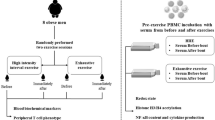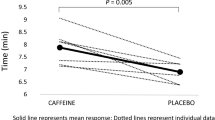Abstract
Purpose
To expand our understanding of the overall anti-inflammatory nature of routine exercise; we compared resting blood values from adults who habitually undertake frequent, moderate levels of exercise to reference interval values assumed to reflect values largely from non-exercisers. This information would be useful for clinicians interpreting blood tests assessing inflammatory, immune and acute phase responses.
Methods
Blood samples were collected from 119 community adult self-reported routine exercisers (61 males and 58 females aged 18–60 years). Samples were analysed for 20 cellular and non-cellular biomarkers which included 11 immunological and 9 acute phase reactants. These data were compared to reference intervals from the same hospital laboratory that performed the analyses on our participants’ samples. Individual analyte values were also compared with participants’ self-reported 150 day exercise patterns which included exercise frequency, intensity and duration.
Results
In general, mean values for routine exercise participants fell at the lower end of laboratory reference interval for most inflammatory analytes. More than 10 % of participants had numbers of CD19+, CD8+ and 16/56+ NK cells below the low end of the respective reference interval. More than 10 % of observed acute phase reactant values (for C3, haptoglobin and ferritin) were also below the low end of the reference interval. At rest IgM (r = −0.22) and IgG (r = −0.31) values correlated negatively (p < 0.05) with exercise load.
Conclusions
Routine exercise appears to lower resting numbers of a variety of immune cell-types as well as the concentration of several classical acute phase reactants. These wide-ranging systemic effects are presumably adaptive changes, not pathology and collectively confirm the well-reported and clinically important anti-inflammatory effects of exercise.


Similar content being viewed by others
Abbreviations
- APR:
-
Acute phase reactants
- CV:
-
Coefficient of variation
- CRP:
-
C-reactive protein
- IGF-1:
-
Insulin-like growth factor-1
- RI:
-
Reference interval (hospital laboratory derived)
- WCC:
-
White blood cell count (total)
References
Ahmadizad S, Haghighi AH, Hamedinia MR (2007) Effects of resistance versus endurance training on serum adiponectin and insulin resistance index. Eur J Endocrinol/Eur Fed Endocr Soc 157(5):625–631. doi:10.1530/EJE-07-0223
Ahmed MS, Jadhav AB, Hassan A, Meng QH (2012) Acute phase reactants as novel predictors of cardiovascular disease. ISRN Inflamm 2012:953461. doi:10.5402/2012/953461
Akimoto T, Kumai Y, Akama T, Hayashi E, Murakami H, Soma R, Kuno S, Kono I (2003) Effects of 12 months of exercise training on salivary secretory IgA levels in elderly subjects. Br J Sports Med 37(1):76–79. doi:10.1136/bjsm.37.1.76
Allen E, Seaman C (2007) Likert scales and data analyses. www.mail.asq.org/quality-progress. Accessed 9 July 2014
Aruoma OI, Reilly T, MacLaren D, Halliwell B (1988) Iron, copper and zinc concentrations in human sweat and plasma; the effect of exercise. Clin Chim Acta; Int J Clin Chem 177(1):81–87
Church TS, Barlow CE, Earnest CP, Kampert JB, Priest EL, Blair SN (2002a) Associations between cardiorespiratory fitness and C-reactive protein in men. Arterioscler Thromb Vasc Biol 22(11):1869–1876
Church TS, Finley CE, Earnest CP, Kampert JB, Gibbons LW, Blair SN (2002b) Relative associations of fitness and fatness to fibrinogen, white blood cell count, uric acid and metabolic syndrome. Int J Obes Relat Metab Disord: J Int Assoc Study Obes 26(6):805–813. doi:10.1038/sj.ijo.0802001
Cooper DM, Radom-Aizik S, Schwindt C, Zaldivar F Jr (2007) Dangerous exercise: lessons learned from dysregulated inflammatory responses to physical activity. J Appl Physiol 103(2):700–709. doi:10.1152/japplphysiol.00225.2007
Du Clos TW (2013) Pentraxins: structure, function, and role in inflammation. ISRN Inflamm 2013:379040. doi:10.1155/2013/379040
Fallon KE, Fallon SK, Boston T (2001) The acute phase response and exercise: court and field sports. Br J Sports Med 35(3):170–173
Fischer CP (2006) Interleukin-6 in acute exercise and training: what is the biological relevance? Exerc Immunol Rev 12:6–33
Gabay C, Kushner I (1999) Acute-phase proteins and other systemic responses to inflammation. N Engl J Med 340(6):448–454. doi:10.1056/NEJM199902113400607
Gleeson M, McDonald WA, Pyne DB, Cripps AW, Francis JL, Fricker PA, Clancy RL (1999) Salivary IgA levels and infection risk in elite swimmers. Med Sci Sports Exerc 31(1):67–73
Gleeson M, Bishop NC, Stensel DJ, Lindley MR, Mastana SS, Nimmo MA (2011) The anti-inflammatory effects of exercise: mechanisms and implications for the prevention and treatment of disease. Nat Rev Immunol 11(9):607–615. doi:10.1038/nri3041
Gregory SM, Spiering BA, Alemany JA, Tuckow AP, Rarick KR, Staab JS, Hatfield DL, Kraemer WJ, Maresh CM, Nindl BC (2013) Exercise-induced insulin-like growth factor I system concentrations after training in women. Med Sci Sports Exerc 45(3):420–428. doi:10.1249/MSS.0b013e3182750bd4
Horn PL, Pyne DB, Hopkins WG, Barnes CJ (2010) Lower white blood cell counts in elite athletes training for highly aerobic sports. Eur J Appl Physiol 110(5):925–932. doi:10.1007/s00421-010-1573-9
Hulver MW, Zheng D, Tanner CJ, Houmard JA, Kraus WE, Slentz CA, Sinha MK, Pories WJ, MacDonald KG, Dohm GL (2002) Adiponectin is not altered with exercise training despite enhanced insulin action. Am J Physiol Endocrinol Metab 283(4):E861–E865. doi:10.1152/ajpendo.00150.2002
Huntoon KM, Wang Y, Eppolito CA, Barbour KW, Berger FG, Shrikant PA, Baumann H (2008) The acute phase protein haptoglobin regulates host immunity. J Leukoc Biol 84(1):170–181. doi:10.1189/jlb.0208100
Hyyppa S, Hoyhtya M, Nevalainen M, Poso AR (2002) Effect of exercise on plasma ferritin concentrations: implications for the measurement of iron status. Equine Vet J Suppl 34:186–190
Institute CaLS (2010) Defining, establishing, and verifying reference intervals in the clinical laboratory; approved guideline. 3rd edn, Clinical Laboratory Standards Institute Publications. https://infostore.saiglobal.com/STORE/Portal.aspx?publisher=NCCLS
Kasapis C, Thompson PD (2005) The effects of physical activity on serum C-reactive protein and inflammatory markers: a systematic review. J Am Coll Cardiol 45(10):1563–1569. doi:10.1016/j.jacc.2004.12.077
Mathur N, Pedersen BK (2009) Exercise as a mean to control low-grade systemic inflammation. Mediators of inflammation 2008. (Epub ahead of print)
McFarlin BK, Flynn MG, Campbell WW, Craig BA, Robinson JP, Stewart LK, Timmerman KL, Coen PM (2006) Physical activity status, but not age, influences inflammatory biomarkers and toll-like receptor 4. J Gerontol Ser A Biol Sci Med Sci 61(4):388–393
McTiernan A, Sorensen B, Yasui Y, Tworoger SS, Ulrich CM, Irwin ML, Rudolph RE, Stanczyk FZ, Schwartz RS, Potter JD (2005) No effect of exercise on insulin-like growth factor 1 and insulin-like growth factor binding protein 3 in postmenopausal women: a 12-month randomized clinical trial. Cancer Epidemiol Biomark Prev 14(4):1020–1021. doi:10.1158/1055-9965.epi-04-0834
Nehlsen-Cannarella SL, Nieman DC, Jessen J, Chang L, Gusewitch G, Blix GG, Ashley E (1991) The effects of acute moderate exercise on lymphocyte function and serum immunoglobulin levels. Int J Sports Med 12(4):391–398. doi:10.1055/s-2007-1024700
Nieman DC, Konrad M, Henson DA, Kennerly K, Shanely RA, Wallner-Liebmann SJ (2012) Variance in the acute inflammatory response to prolonged cycling is linked to exercise intensity. J Interferon Cytokine Res: Off J Int Soc Interferon Cytokine Res 32(1):12–17. doi:10.1089/jir.2011.0038
Nishida Y, Matsubara T, Tobina T, Shindo M, Tokuyama K, Tanaka K, Tanaka H (2010) Effect of low-intensity aerobic exercise on insulin-like growth factor-I and insulin-like growth factor-binding proteins in healthy men. Int J Endocrinol. doi:10.1155/2010/452820
Parisotto R, Pyne D, Martin D, Gore C, Fallon K, Fricker P, Hahn A (2003) Neutropenia in elite male cyclists. Clin J Sport Med 13(5):303–305
Pedersen BK, Fischer CP (2007) Beneficial health effects of exercise—the role of IL-6 as a myokine. Trends Pharmacol Sci 28(4):152–156. doi:10.1016/j.tips.2007.02.002
Peeling P, Dawson B, Goodman C, Landers G, Trinder D (2008) Athletic induced iron deficiency: new insights into the role of inflammation, cytokines and hormones. Eur J Appl Physiol 103(4):381–391. doi:10.1007/s00421-008-0726-6
Petersen A, Pedersen B (2005) The anti-inflammatory effect of exercise. J Appl Physiol 98(4):1154–1162
Semple S, Smith L, McKune A, Neveling N, Wadee A (2004) Alterations in acute-phase reactants (CRP, rheumatoid factor, complement, factor B, and immune complexes) following an ultramarathon. S Afr J Sports Med 16(2):17–21
Seshadri V, Fox PL, Mukhopadhyay CK (2002) Dual role of insulin in transcriptional regulation of the acute phase reactant ceruloplasmin. J Biol Chem 277(31):27903–27911. doi:10.1074/jbc.M203610200
Slentz CA, Aiken LB, Houmard JA, Bales CW, Johnson JL, Tanner CJ, Duscha BD, Kraus WE (2005) Inactivity, exercise, and visceral fat. STRRIDE: a randomized, controlled study of exercise intensity and amount. J Appl Physiol 99(4):1613–1618. doi:10.1152/japplphysiol.00124.2005
Spitler DL, Alexander WC, Hoffler GW, Doerr DF, Buchanan P (1984) Haptoglobin and serum enzymatic response to maximal exercise in relation to physical fitness. Med Sci Sports Exerc 16(4):366–370
Statistics ABo (2013) Australian health survey: physical activity (2011–2012). Australian Government, Canberra
Tabas I, Glass CK (2013) Anti-inflammatory therapy in chronic disease: challenges and opportunities. Science 339(6116):166–172. doi:10.1126/science.1230720
Trayhurn P, Wood IS (2004) Adipokines: inflammation and the pleiotropic role of white adipose tissue. Br J Nutr 92(3):347–355
West NP, Horn PL, Pyne DB, Gebski VJ, Lahtinen SJ, Fricker PA, Cripps AW (2014) Probiotic supplementation for respiratory and gastrointestinal illness symptoms in healthy physically active individuals. Clin Nutr 33(4):581–587. doi:10.1016/j.clnu.2013.10.002
Acknowledgments
We thank our participants for their involvement in the study. We also acknowledge the statistical advice of Rod Lea and Susan Barrett, Griffith Health Institute, Griffith University, Gold Coast, Queensland, Australia. The technical contributions of Lachlan Mitchell of the Australian Institute of Sport, and Mary Brun of A.C.T. Pathology, Canberra Hospital are also acknowledged. This study was partially funded by Danisco Sweeteners Oy, a subsidiary of DuPont.
Author information
Authors and Affiliations
Corresponding author
Additional information
Communicated by Fabio Fischetti.
Rights and permissions
About this article
Cite this article
Horn, P.L., West, N.P., Pyne, D.B. et al. Routine exercise alters measures of immunity and the acute phase reaction. Eur J Appl Physiol 115, 407–415 (2015). https://doi.org/10.1007/s00421-014-3028-1
Received:
Accepted:
Published:
Issue Date:
DOI: https://doi.org/10.1007/s00421-014-3028-1




